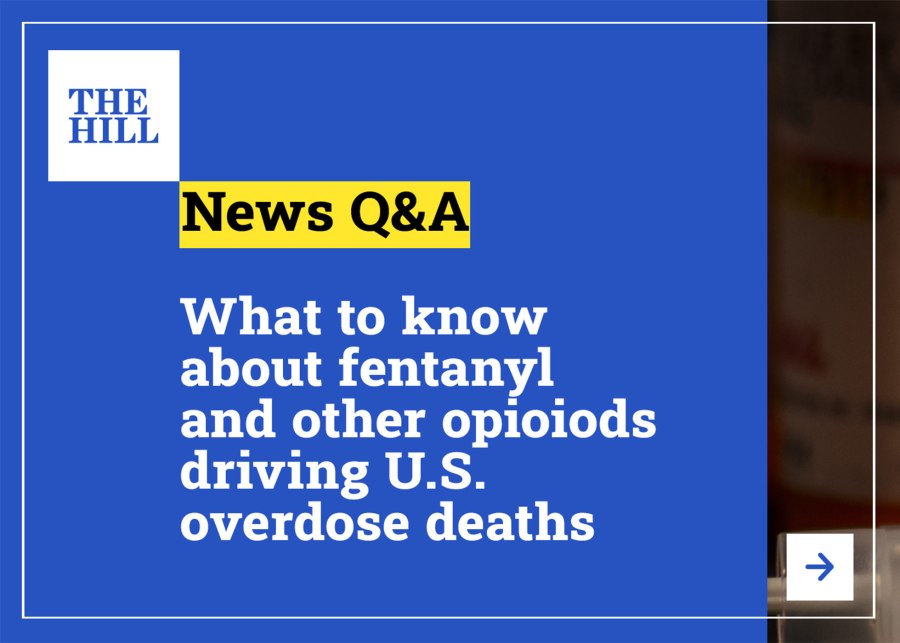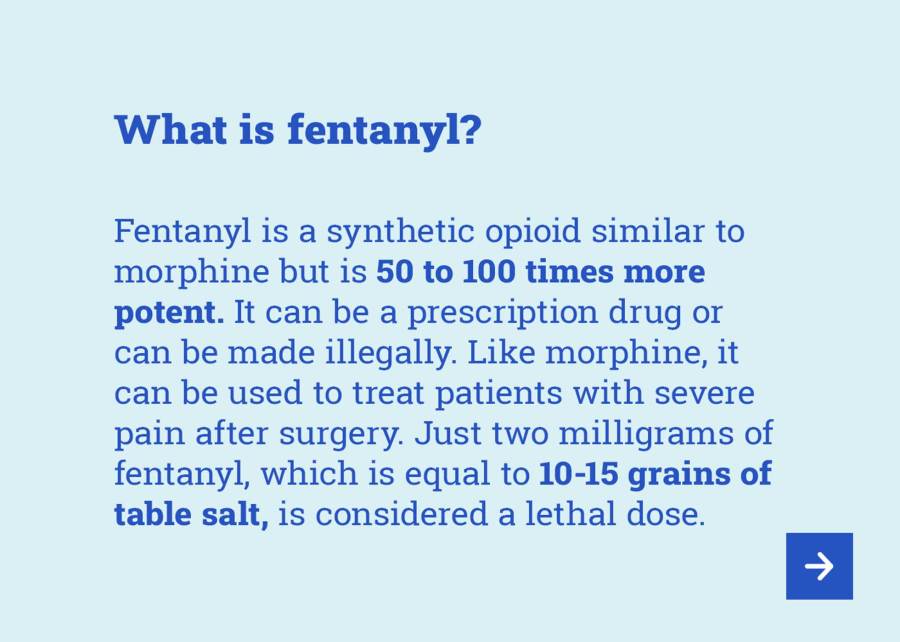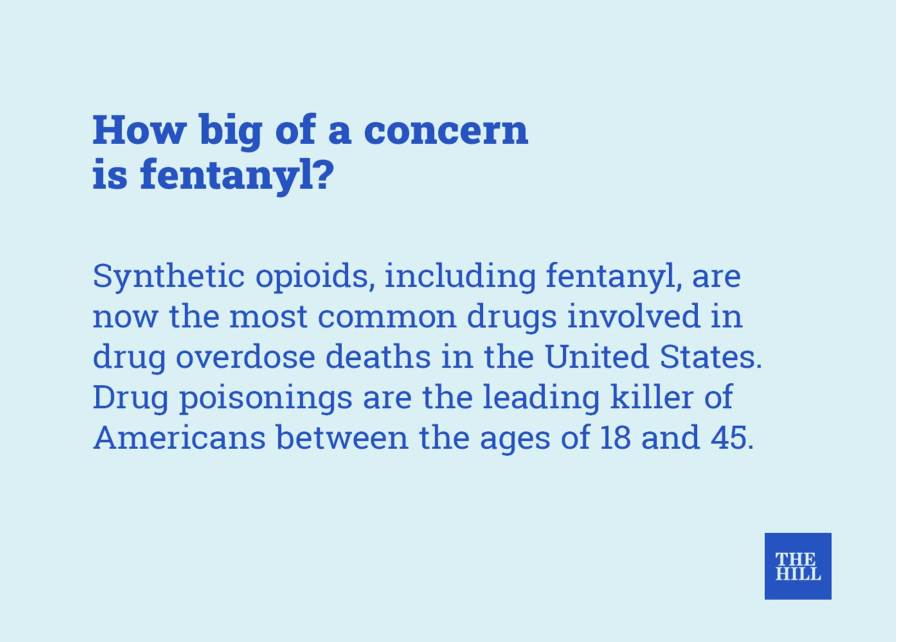As US fentanyl deaths jump, GOP casts blame at the border
Editor’s note: This is the first part of a two-part series on the politicization of fentanyl overdoses.
The Republican takeover of the House shifted congressional oversight of the border, with GOP lawmakers using their new powers in efforts to link the fentanyl crisis to migration.
Fentanyl has increased the stakes in the decades-long drug war, inflaming the preexisting opiate crisis and bickering over border security, with a heightened lethality not shared by other recreational drugs.
The GOP has put a spotlight on fentanyl, portraying it as the connective tissue among immigration, crime, border chaos and the overdose epidemic.
In recent weeks the drug has been a fixture of GOP hearings, with House Homeland Security Chairman Mark Green (R-Tenn.) claiming “backpacks full of fentanyl [are] pouring into our country” while border officers are stretched thin in responding to migrants.
But statistics around fentanyl paint another picture, one in which American citizens are trafficking the drug to meet U.S. demand, with 90 percent of fentanyl captured as it is driven into the country through border crossing checkpoints.
“To hear many of my colleagues, you’d be led to believe that vulnerable migrants are the ones bringing these drugs into the United States,” said Rep. Veronica Escobar (D-Texas) who represents an El Paso district along the border.
“What we have failed repeatedly to do in our country is talk about the demand for these drugs. And you know, the focus has always been on the supply. And I really wish my colleagues would be as passionate about addressing addiction and the demand for illegal substances as they are passionate about the supply of them,” she said.
“We’re never going to get past our substance abuse issues as a country until we deal with both ends. And until we talk about this in an honest way,” Escobar added.
A flood of fentanyl
Fentanyl, a synthetic opioid, has been used in regulated pharmaceutical production since the 1960s. But its recreational use, backed by production from illegal labs, has proved especially dangerous given the potency of a drug up to 50 times stronger than heroin and 100 times stronger than morphine.
As a street drug, fentanyl is largely produced by clandestine labs in Mexico from chemical precursors sourced from China, according to the State Department’s 2022 International Narcotics Control Strategy Report.
The drug killed some 70,000 Americans last year, part of a growing trend of synthetic opioids that now account for more than three quarters of all overdose deaths.
Its path to the U.S. is surprisingly straightforward; data from U.S. Customs and Border Protection shows 90 percent or more of fentanyl seizures have happened at U.S. ports of entry, while a fraction of fentanyl is captured between ports of entry.
And U.S. Sentencing Commission data shows that the vast majority of those convicted of trafficking fentanyl into the U.S. are American citizens.
A review of sentencing records from the Cato Institute found that last year, 86 percent of those convicted of trafficking fentanyl were U.S. citizens, while 9 percent of those who brought fentanyl into the country were foreigners with no legal status in the U.S.
“Despite arresting over 700,000 illegal entrants so far this year, less than 1 percent of CBP’s fentanyl seizures have come from people carrying it across the border illegally,” David Bier, the group’s associate director of immigration studies, told lawmakers last month. “Maybe it’s right to investigate the scourge of fentanyl deaths. But immigrants are not the cause.”
Experts say it’s easier for cartels to have people with U.S. passports transport the drug, crossing the border at a designated port where the risk of search is minimal and the majority of cars are waved through.
That trend was on display as fentanyl seizures spiked at the start of the pandemic, with former President Trump shutting down the U.S.-Mexico border to all but essential traffic – including returning U.S. citizens.
The limited traffic meant officers were able to search a greater share of cars crossing the border, and the proportion of border searches that found fentanyl shot up fourfold.
Meanwhile, the data shows little correlation between migration and fentanyl.
“When migration goes up, fentanyl numbers don’t change; when migration goes down, fentanyl numbers don’t change either,” said Aaron Reichlin-Melnick, policy counsel at the American Immigration Council.
“If it were true that high numbers of migrants led to more fentanyl making it across the border without being detected, you would expect to see that in the drug and migration data. But you just don’t,” he said.
Fentanyl at the forefront
Regardless of how fentanyl is crossing the border, its consumption and lethality have made it a political red meat issue.
Though many in the GOP now stop short of accusing asylum-seekers and economic migrants of acting as mules for smugglers, they still link migration to drug smuggling on the premise that smugglers direct migrant flows to open smuggling lanes.
Still, polling has shown that Americans by and large conflate the two issues; an NPR-Ipsos poll in August found that more than half of respondents believed an “invasion” was taking place at the southern border, and 50 percent said migrants carrying fentanyl over the border are “responsible for the increase in drug overdoses.”
Despite Department of Homeland Security data pointing to U.S. citizens at ports of entry as the main source of fentanyl, Republicans say high overdose death rates suggest other streams of fentanyl into the country.
“CBP drug seizure numbers only capture screened activity at ports of entry (POEs). Unlike its ability to track known gotaway aliens, CBP does not have the capability or technology to track drugs entering between POEs,” Green told The Hill in an email.
And Republicans generally are not buying the administration’s analysis of trafficking routes — the laser focus on ports of entry, say Republicans, raises more questions than it answers.
Green noted that fentanyl overdoses continued to increase during the pandemic, when ports of entry were ostensibly closed to nonessential travel.
“How is this possible if fentanyl doesn’t get trafficked between POE? And even as fentanyl seizures remained stagnate at POEs when they reopened, the number of deaths from fentanyl continued to rise,” Green said.
“How do we explain that? This fentanyl is coming from somewhere, it’s time for this administration to stop diverting blame or making excuses and instead put a stop to it.”
Still, the potency and irregular quality of cartel lab fentanyl raise the possibility that any substantial supply of the drug will result in a high overdose death rate.
It’s something both Republicans and Drug Enforcement Administration officials have noted when referring to statistics that enough fentanyl has been seized to kill every American. That’s in part because just two milligrams, an amount akin to the size of the tip of a pencil, can be deadly.
But Reichlin-Melnick said there’s little evidence to suggest fentanyl is pouring across the border by those on foot. In his own review of roughly 500 publicly reported incidents over the last two years in which CBP agents seized fentanyl either at or between ports of entry, just nine were reported as having been brought in on foot.
“There is no doubt that this does happen on an isolated basis,” he said. “But there is no evidence the amount of fentanyl or other drugs that come across the border in such instances are anything other than the trickle compared to what is coming in through the front door at ports of entry.”
The Department of Homeland Security recently touted the newly installed technology that helps them root out fentanyl at ports of entry, noting that “non-intrusive inspection technology, including the deployment of Multi Energy Portals in the cargo environment” helped law enforcement seize 900 pounds of fentanyl in the first week of a new project targeting the drug, called Operation Blue Lotus.
That marked an increase from the average weekly haul in February 2023, which was about 575 pounds, and an average of 283 pounds in weekly seizures in 2022.
Meanwhile, Democrats are still fuming that many Republicans voted against the infrastructure law passed in 2021 that included funding for modernizing land ports and boosting screening at the border.
Rep. Raúl Grijalva (D-Ariz.) said the high seizure rates at ports justify the investment there.
“Why is not the investment in that security deterrent? And you’re still dealing with stopping the product, you’re stopping the source. Pretending that everybody that is here, every migrant is somehow carrying the fentanyl into this country, it’s part of the stereotype created to talk about the border and sealing the border,” said Grijalva.
“You have to deal with the source, no question,” he added. “But to ignore demand, ignore treatment, ignore other kinds of interventions to continue to try to satisfy this false narrative about ‘we’ve got to seal the border, that’s the only way to stop it’ serves their political interest more than it does solving the problem.”
Public health or border issue?
According to the Centers for Disease Control and Prevention, monthly synthetic opioid deaths have grown tenfold since 2015, alarming lawmakers on both sides of the aisle.
Michael Barnett, an associate professor at the Harvard T. H. Chan School of Public Health, said the opioid epidemic began as an offshoot of a successful marketing campaign pushed by pharmaceutical manufacturers.
But the crisis has shifted over decades, with many users now seeking fentanyl as a substitute for heroin and prescription opiates. Mexican production of fentanyl, he said, is meeting a growing U.S. demand — one the government has failed to stem.
“This is, I think, a classic messaging tactic, which is blaming outsiders for a problem that is a very American, very complex policy issue,” Barnett said.
“And it makes for way better on TV to show pictures of the border and talk about enforcement issues and individual horror stories of things that are happening at the border than to talk about the nitty gritty of how we get people access to services they need,” he added.
“But really, we’re the ones who have to take responsibility for it, because blaming others hasn’t gotten us very far.”
Copyright 2023 Nexstar Media Inc. All rights reserved. This material may not be published, broadcast, rewritten, or redistributed.







